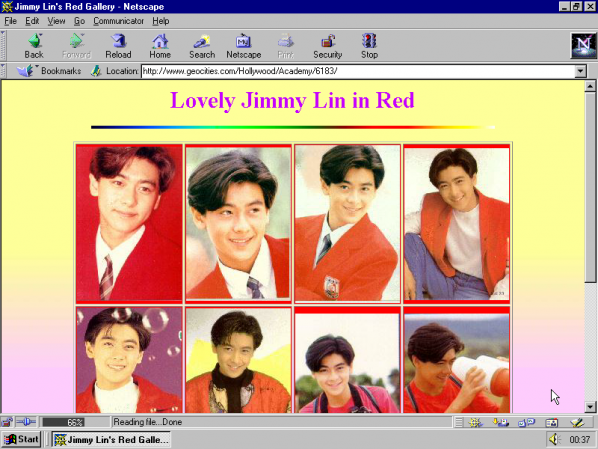



The new project by Guido Segni is so monumental in scope and so multitudinous in its implications that it can be a bit slippery to get a handle on it in a meaningful way. A quiet desert failure is one of those ideas that is deceptively simple on the surface but look closer and you quickly find yourself falling down a rabbit-hole of tangential thoughts, references, and connections. Segni summarises the project as an “ongoing algorithmic performance” in which a custom bot programmed by the artist “traverses the datascape of Google Maps in order to fill a Tumblr blog and its datacenters with a remapped representation of the whole Sahara Desert, one post at a time, every 30 minutes.”1
Opening the Tumblr page that forms the core component of A quiet desert failure it is hard not to get lost in the visual romanticism of it. The page is a patchwork of soft beiges, mauves, creams, and threads of pale terracotta that look like arteries or bronchia. At least this morning it was. Since the bot posts every 30 minutes around the clock, the page on other days is dominated by yellows, reds, myriad grey tones. Every now and then the eye is captured by tiny remnants of human intervention; something that looks like a road, or a small settlement; a lone, white building being bleached by the sun. The distance of the satellite, and thus our vicarious view, from the actual terrain (not to mention the climate, people, politics, and more) renders everything safely, sensuously fuzzy; in a word, beautiful. Perhaps dangerously so.
As is the nature of social media platforms that prescribe and mediate our experience of the content we access through them, actually following the A quiet desert failure Tumblr account and encountering each post individually through the template of the Tumblr dashboard provides a totally different layer to the work. On the one hand this mode allows the occasional stunningly perfect compositions to come to the fore – see image below – some of these individual ‘frames’ feel almost too perfect to have been lifted at random by an aesthetically indifferent bot. Of course with the sheer scope of visual information being scoured, packaged, and disseminated here there are bound to be some that hit the aesthetic jackpot. Viewed individually, some of these gorgeous images feel like the next generation of automated-process artworks – a link to the automatic drawing machines of, say, Jean Tinguely. Although one could also construct a lineage back to Duchamp’s readymades.

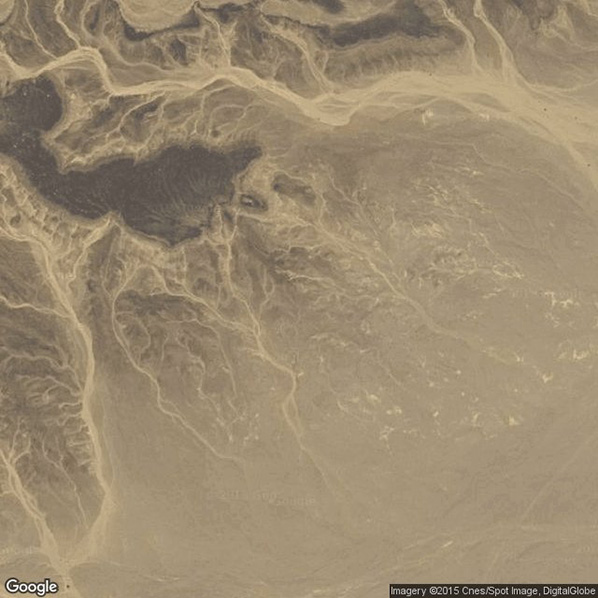
Segni encourages us to invest our aesthetic sensibility in the work. On his personal website, the artist has installed on his homepage a version of A quiet desert failure that features a series of animated digital scribbles overlaid over a screenshot of the desert images the bot trawls for. Then there is the page which combines floating, overlapping, translucent Google Maps captures with an eery, alternately bass-heavy then shrill, atmospheric soundtrack by Fabio Angeli and Lorenzo Del Grande. The attention to detail is noteworthy here; from the automatically transforming URL in the browser bar to the hat tip to themes around “big data” in the real time updating of the number of bytes of data that have been dispersed through the project, Segni pushes the limits of the digital medium, bending and subverting the standardised platforms at every turn.
But this is not art about an aesthetic. A quiet desert failure did begin after the term New Aesthetic came to prominence in 2012, and the visual components of the work do – at least superficially – fit into that genre, or ideology. Thankfully, however, this project goes much further than just reflecting on the aesthetic influence of “modern network culture”2 and rehashing the problematically anthropocentric humanism of questions about the way machines ‘see’. Segni’s monumental work takes us to the heart of some of the most critical issues facing our increasingly networked society and the cultural impact of digitalisation.
The Sahara Desert is the largest non-polar desert in the world covering nearly 5000 km across northern Africa from the Atlantic ocean in the west to the Red Sea in the east, and ranging from the Mediterranean Sea in the north almost 2000 km south towards central Africa. The notoriously inhospitable climate conditions combine with political unrest, poverty, and post-colonial power struggles across the dozen or so countries across the Sahara Desert to make it surely one of the most difficult areas for foreigners to traverse. And yet, through the ‘wonders’ of network technologies, global internet corporations, server farms, and satellites, we can have a level of access to even the most problematic, war-torn, and infrastructure-poor parts of the planet that would have been unimaginable just a few decades ago.
A quiet desert failure, through the sheer scope of the piece, which will take – at a rate of one image posted every 30 minutes – 50 years to complete, draws attention to the vast amounts of data that are being created and stored through networked technologies. From there, it’s only a short step to wondering about the amount of material, infrastructure, and machinery required to maintain – and, indeed, expand – such data hoarding. Earlier this month a collaboration between private companies, NASA, and the International Space Station was announced that plans to launch around 150 new satellites into space in order to provide daily updating global earth images from space3. The California-based company leading the project, Planet Labs, forecasts uses as varied as farmers tracking crops to international aid agencies planning emergency responses after natural disasters. While it is encouraging that Planet Labs publishes a code of ethics4 on their website laying out their concerns regarding privacy, space debris, and sustainability, there is precious little detail available and governments are, it seems, hopelessly out of date in terms of regulating, monitoring, or otherwise ensuring that private organisations with such enormous access to potentially sensitive information are acting in a manner that is in the public interest.
The choice of the Sahara Desert is significant. The artist, in fact, calls an understanding of the reasons behind this choice “key to interpret[ing] the work”. Desertification – the process by which an area becomes a desert – involves the rapid depletion of plant life and soil erosion, usually caused by a combination of drought and overexploitation of vegetation by humans.5 A quiet desert failure suggests “a kind of desertification taking place in a Tumblr archive and [across] the Internet.”6 For Segni, Tumblr, more even than Instagram or any of the other digitally fenced user generated content reichs colonising whatever is left of the ‘free internet’, is symbolic of the danger facing today’s Internet – “with it’s tons of posts, images, and video shared across its highways and doomed to oblivion. Remember Geocities?”7
From this point of view, the project takes on a rather melancholic aspect. A half-decade-long, stately and beautiful funeral march. An achingly slow last salute to a state of the internet that doesn’t yet know it is walking dead; that goes for the technology, the posts that will be lost, the interior lives of teenagers, artists, nerds, people who would claim that “my Tumblr is what the inside of my head looks like”8 – a whole social structure backed by a particular digital architecture, power structure, and socio-political agenda.
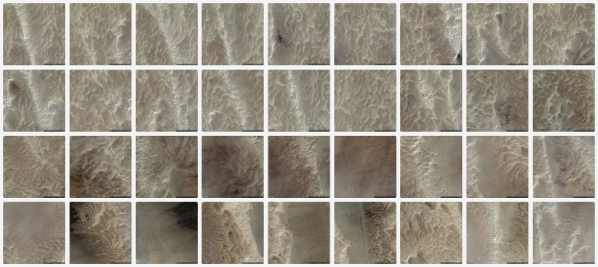
The performative aspect of A quiet desert failure lies in the expectation of its inherent breakdown and decay. Over the 50 year duration of the performance – not a randomly selected timeframe, but determined by Tumblr’s policy regulating how many posts a user can make in a day – it is likely that one or more of the technological building blocks upon which the project rests will be retired. In this way we see that the performance is multi-layered; not just the algorithm, but also the programming of the algorithm, and not just that but the programming of all the algorithms across all the various platforms and net-based services incorporated, and not just those but also all the users, and how they use the services available to them (or don’t), and how all of the above interact with new services yet to be created, and future users, and how they perform online, and basically all of the whole web of interconnections between human and non-human “actants” (as defined by Actor- network theory) that come together to make up the system of network, digital, and telecommunications technologies as we know them.
Perhaps the best piece I know that explains this performativity in technology is the two-minute video New Zealand-based artist Luke Munn made for my Net Work Compendium – a curated collection of works documenting the breadth of networked performance practices. The piece is a recording of code that displays the following text, one word at a time, each word visible for exactly one second: “This is a performance. One word per second. Perfectly timed, perfectly executed. All day, every day. One line after another. Command upon endless command. Each statement tirelessly completed. Zero one, zero one. Slave to the master. Such was the promise. But exhaustion is inevitable. This memory fills up. Fragmented and leaking. This processor slows down. Each cycle steals lifecycle. This word milliseconds late. That loop fractionally delayed. Things get lost, corrupted. Objects become jagged, frozen. The CPU is oblivious to all this. Locked away, hermetically sealed, completely focused. This performance is always perfect.”
Guido Segni’s A quiet desert failure is, contrary to its rather bombastic scale, a finely attuned and sensitively implemented work about technology and our relationship to it, obsolescence (planned and otherwise), and the fragility of culture (notice I do not write “digital” culture) during this phase of rapid digitalisation. The work has been released as part of The Wrong – New Digital Art Biennale, in an online pavilion curated by Filippo Lorenzin and Kamilia Kard, inexactitudeinscience.com.
Featured image: A random Geocities homepage, last updated sometime around 1997
Daniel Rourke visits the Photographers’ Gallery in central London and reviews their latest exhibit One Terabyte of Kilobyte Age by artists Olia Lialina and Dragan Espenschied, on THE WALL. Over an eight week period (18 April – 17 June 2013) they feature a non-stop stream of video captures of what they term as the lost city and its archival ruins. A documentation of a past visual culture of the web and the creativity of its users with new pages changing every 5 minutes. The project provides a glimpse into web publishing when users were in charge of design and narration in contrast to the automated templates of Facebook, YouTube and Flickr.
Sifting through a dormant internet message board, or stumbling, awestruck, on a kippleised [1] html homepage, its GIF constellations still twinkling many years after the owner has abandoned them, is an encounter with the living, breathing World Wide Web. At such moments we are led, so argues Marisa Olson, ‘to consider the relationship between taxonomy à la the stuffed-pet metaphor and taxonomy à la the digital archive.’ [2] How such descript images, contrived jumbles of memory and experience, could once have felt so essential to the person who collated them, yet now seem so indecipherable, stagnant, even – dare we admit it – insane to anyone but the most hardened retro-web enthusiast.
On show at London’s Photographers gallery until June 17th is an extensive archival exhibit designed to manage, reveal and keep these experiences alive. One Terabyte Of Kilobyte Age (1tb) is the fifth work to be commissioned for the Photographer Gallery’s ‘The Wall’, curated by two artists long associated with the era of the web the exhibition reveres: Olia Lialina and Dragan Espenschied. Perhaps best known for their book Digital Folklore (2009) the artists and retro-web evangelists have, with the 1tb project, strengthened their status as archivists, an impulse Hal Foster famously argued ‘concerned less with absolute origins than with obscure traces’ [3]. In the same year that Dragan and Olia launched their guide to the folk web, Yahoo! announced they were to close one of its greatest sources of inspiration: Geocities. A vast expanse of personal webpages, many of which had long since slid into html decrepitude, represented for Yahoo! little but financial embarrassment. So ancient and outmoded was Geocities that many contemporary browsers were incapable of capturing its essence, fragmenting images and link rolls randomly across modern laptop screens in an attempt to render their 800×600 pixel aura. Scraping and downloading the terabyte or so of data that made up the Geocities universe was thought important enough by some that a taskforce was put together, made up of technical wizards and wizardesses driven by the profound notion that all existent culture is worth saving. From Olia and Dragan’s webpage:
In between the announcement and the official date of death a group of people calling themselves Archive Team — managed to rescue almost a terabyte of Geocities pages. On the 26th of October 2010, the first anniversary of this Digital Holocaust, the Archive Team started to seed geocities.archiveteam.torrent.
Olia and Dragan’s gesture, to feed the wealth of culture contained in that torrent back to the masses in a palatable form, is a project whose fruition at the Photographer’s Gallery is but a minor part. After downloading, storing and sorting the 16,000 archived Geocities sites the task of exactly how to display them is a problem. Since most browsers would mangle the look and feel of the Geocities pages Olia and Dragan have turned to two main methods of re-representation. The first, let loose on an automated Tumblr blog that updates over 70 times a day, is an ever growing series of front-page screen captures. In this form 1tb bends to the will of a contemporary web user who concerns themselves with likes, reposts and uplinks.
Reflecting on the Tumblr-archive of the torrent-archive of the Geocities-archive, Olia and Dragan’s site contemporary-home-computing highlights particular screen captures that have garnered the most reposts and likes from their Tumblr followers. The results say much for the humour that still drives online culture, but perhaps little about the original contexts from whence those screen captures came. For instance, the screen captures that garner most attention are usually the ones that have failed a part of the retrieval/display/capture process. These ‘obscure traces’ may be GIF heavy sites, half loaded to interesting aesthetic affect, or, perhaps the most telling, captures that show nothing but the empty shell of a Netscape Navigator browser, caught forever like a millennium bug in digital amber.
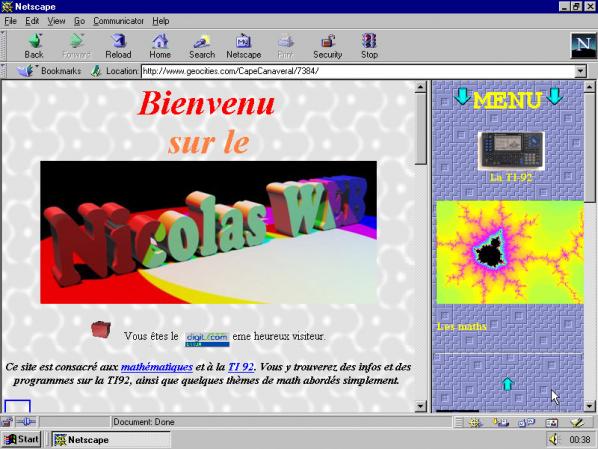
The second mode of capture and re-display takes place at the Photographer’s Gallery itself. Depicted on nine large intersecting HD video screens set into ‘The Wall’ of the entrance-cum-café, one’s first experience of the exhibit is ponderous. The display cycles through the vast array of Geocities homepages at five minute intervals, giving viewers a more than generous dose of 800×600 px nostalgia. Whether the websites that fade into view are a barrage of animated GIFs,insightful commentary on life in the late 1990s, or a series of barren ‘Under Construction’ assemblages, is up to chance.
As a reviewer, sent to derive something from the gallery experience, the wall leered at me with gestures that sent my inner taxonomist into a frenzy. Confronted with such tiny slithers of the archive, in such massive doses, it quickly becomes obvious that the real potential of the project has not been quite realised. Rather than static screen captures The Wall shows cleverly rendered quicktime videos, allowing the GIF whiskers of a Hello Kitty mascot to quiver once more. If you are lucky, or have the patience to watch a long series of the sites fade into view, you’ll be greeted by flickering ‘Welcome’ banners, by cartoon workmen tirelessly drilling, by unicorns cantering and sitemeter bars flashing. But The Wall also feels wholly at odds with its content, caught up in a whirl of web nostalgia that minimises the lives, experiences and aesthetic choices of a defining generation to static flashes that you can’t click on, no matter how much you want to. Archives are living, breathing entities wont to be probed for new meanings and interpretations. Whether depicted as static or faux animated, One Terabyte Of Kilobyte Age is a project with an endless surface, with little way for its viewers to delve deeper.
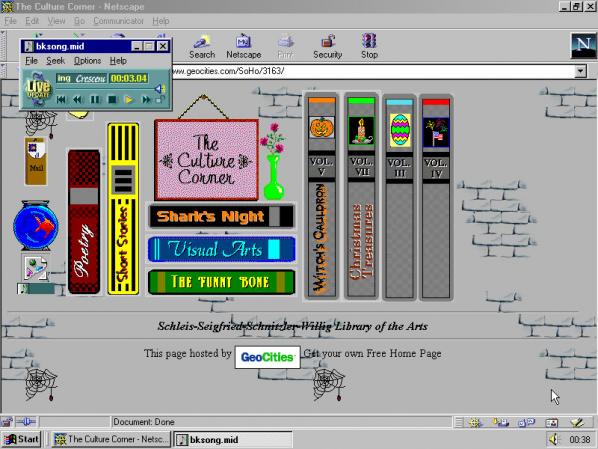
Trawling through the 1tb Tumblr is a much more visceral experience than the one that greets you at the Photographer’s Gallery, but the sense of a journey waiting to be embarked on is lost somewhat in the move to the Tumblr kingdom. Every five minutes offers a new chance to spot similarities on The Wall, to ponder on the origins of a site or, more profoundly, wonder where the people that toiled to make them are now. Before the days of user driven content, of Facebook timelines, and even before RSS feed aggregators, the whole web felt something like this. Today’s web is unarguably more dynamic, with a clean aesthetic that barely shifts behind the waves of content that wash over its surface. But the user has been relegated to shuffler of material.
The Geocities homepage was designed, and kept updated by an army of amateur enthusiasts, organising bandwidth light GIFs in ever more meaningful arrays, in the unlikely event that another living soul would stumble upon them. There is much to love about One Terabyte Of Kilobyte Age, and much to be learned from it given the time. But part of me wishes that the Photographer’s Gallery had given over their trendy café to a row of beige Intel 486 computer stacks, their unwieldy tube monitors better capturing the spirit of the web alá 1996. The clash between the 90s amateur enthusiast and the avid content shuffler of the 2010s is inherent in the modes of display Olia and Dragan chose for their project. Beginning from a desire to save and reflect on our shared heritage, 1tb now represents itself as pure content. An impulse to probe the archive replaced by an impulse to scroll endlessly through Tumblr streams, clicking like buttons on screen captures we hope will distract/impress/outrage our friends until the next cat video refreshes into view.
Go, go to the Photographer’s Gallery tomorrow, grab yourself a coffee and let the Geocities archive wash over you. If you can do it without Instagramming a snap to your friends, without updating your Facebook page with tales of your nostalgic reverie, if you can let the flickering screen captures do their own talking , only then can you claim you truly re-entered the kilobyte age.
